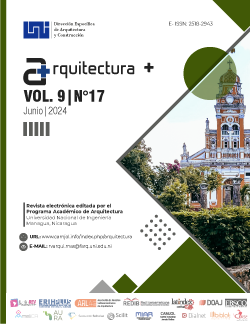The importance of LEED certification in healthcare architectural projects
DOI:
https://doi.org/10.5377/arquitectura.v9i17.17940Keywords:
Design, environmental-impact, health, hospitals, LEED-certificationAbstract
The worldwide demand for hospitals has increased over time, this space being the reflection of various historical events that have forced it to adapt to various physical, social and environmental conditions that society faces, to its time, lacking spaces essential for its operations. The purpose of this article is to raise awareness among architects for the implementation of design strategies with the use of clean energy, especially in the health sector, at a national and international level since, as is known, these are the hospitals that generate the highest index. of contamination in the waste (organic, inorganic and RPBI) that is produced daily as well as the architectural space that consumes the most energy, for example "According to the Development Bank of Latin America (13), a typical distribution of energy consumption in hospitals It would be: 51% in air conditioning, 12% in ventilation and pumps, 6% in domestic hot water, 14% in lighting and 17% in equipment. With this background, through a more empathetic approach to the environment, integrating LEED standards into the design as an urgent alternative, it is intended that with this implementation of certification in the health sector, and properly equipped spaces, they will improve quality, medical care and avoid expenses. unnecessary energy. Another implementation is green spaces that benefit us in different ways, since there are studies that suggest that these reduce unfavorable health conditions including cardiovascular pathologies, diabetes and cancer. There is a great social/environmental problem that requires raising awareness for future constructions by integrating various factors, since population growth strongly demands resources and spaces, creating collapse in emergency situations, which is why buildings must respond to current and future demands.
Downloads
277
References
Betancourt, E. (Marzo de 2019). Bioconstrucción y Energía Alternativa, SA de CV . Obtenido de Bioconstrucción y Energía Alternativa, SA de CV : https://bioconstruccion.com.mx/clinica-hospital-issste-merida/
Edwards, B. (2004). Guía Basica de la sostenibilidad (24/03/2004 ed.). Barcelona: GG - 9788425219511.
González, J. F. (1 de Marzo de 2014). construcción y tecnología en concreto . Obtenido de construcción y tecnología en concreto : http://www.imcyc.com/revistacyt/index.php/portada/151-hospital-regional-de-tlalnepantla#:~:text=La%20monumental%20obra%20comenz%C3%B3%20a,el%20mejor%20proyecto%20de%20aso.
Group, G. (s./f.). Green Group Sustainability Consulting. Obtenido de Green Group Sustainability Consulting: https://www.greengroup.com.ar/detalle.php?a=leed-edificios-existentes&t=15&d=118
Instituto de Seguridad y Servicios Sociales de los Trabajadores del Estado. (19 de Mayo de 2018). Gobierno de México. Obtenido de Gobierno de México: https://www.gob.mx/issste/prensa/entra-en-funcionamiento-clinica-hospital-merida-del-issste?idiom=es
Marhnos. (19 de Diciembre de 2017). ArquiRED. Obtenido de ArquiRED: https://www.arquired.com.mx/arq/hospital-regional-tlalnepantla-primer-proyecto-salud-en-recibir-certificacion-leed-en-mexico/
Marhnos® Corporativo. (2017). MARHNOS®. Obtenido de MARHNOS®: https://www.marhnos.com.mx/marhnos-primera-certificacion-leed-mexico/
Martin Caballer, A. C. (2014). El hospital verde. Madrid: Ediciones Díaz de Santos .
Ottelin, A. A. (2019). ¿ Son los edificios con certificación LEED energéticamete eficientes en la práctica? Universidad Aalto, 00076 Espoo, Finlandia.
Renovables, E. (2019). Eficiencia. Energias renovables.
Sandra Mancini, B. J. (s.f.). ¿Los edificios con certificación LEED ahorran energía?
Social, I. M. (1993). Normas Bioclimaticas. México Ciudad de México: IMSS.
Downloads
Published
How to Cite
Issue
Section
License
Copyright (c) 2024 Universidad Nacional de Ingeniería

This work is licensed under a Creative Commons Attribution-NonCommercial-NoDerivatives 4.0 International License.



















